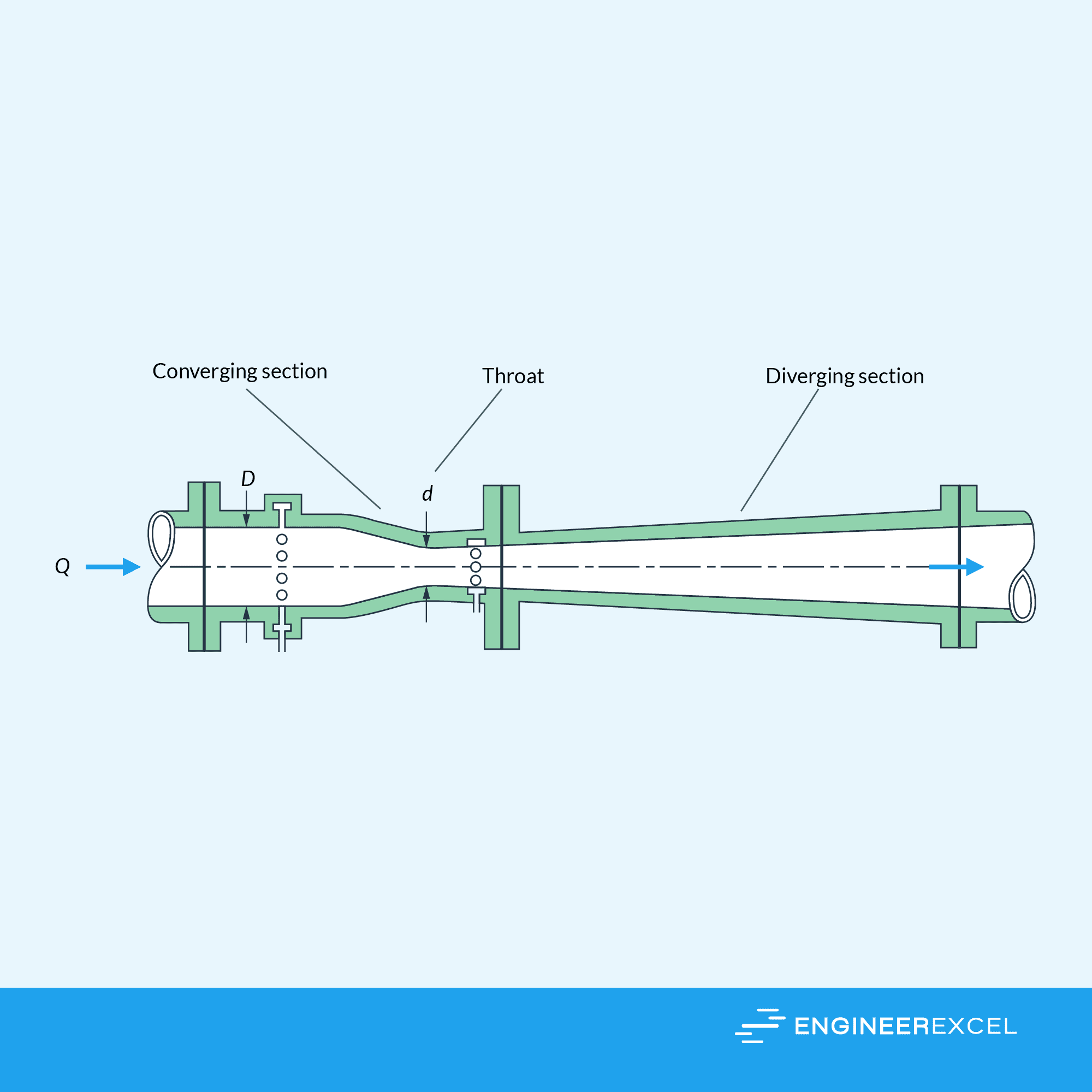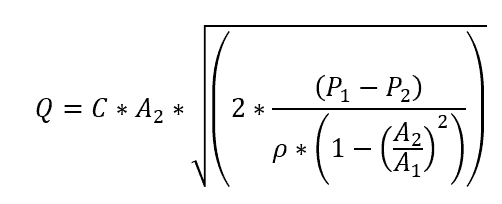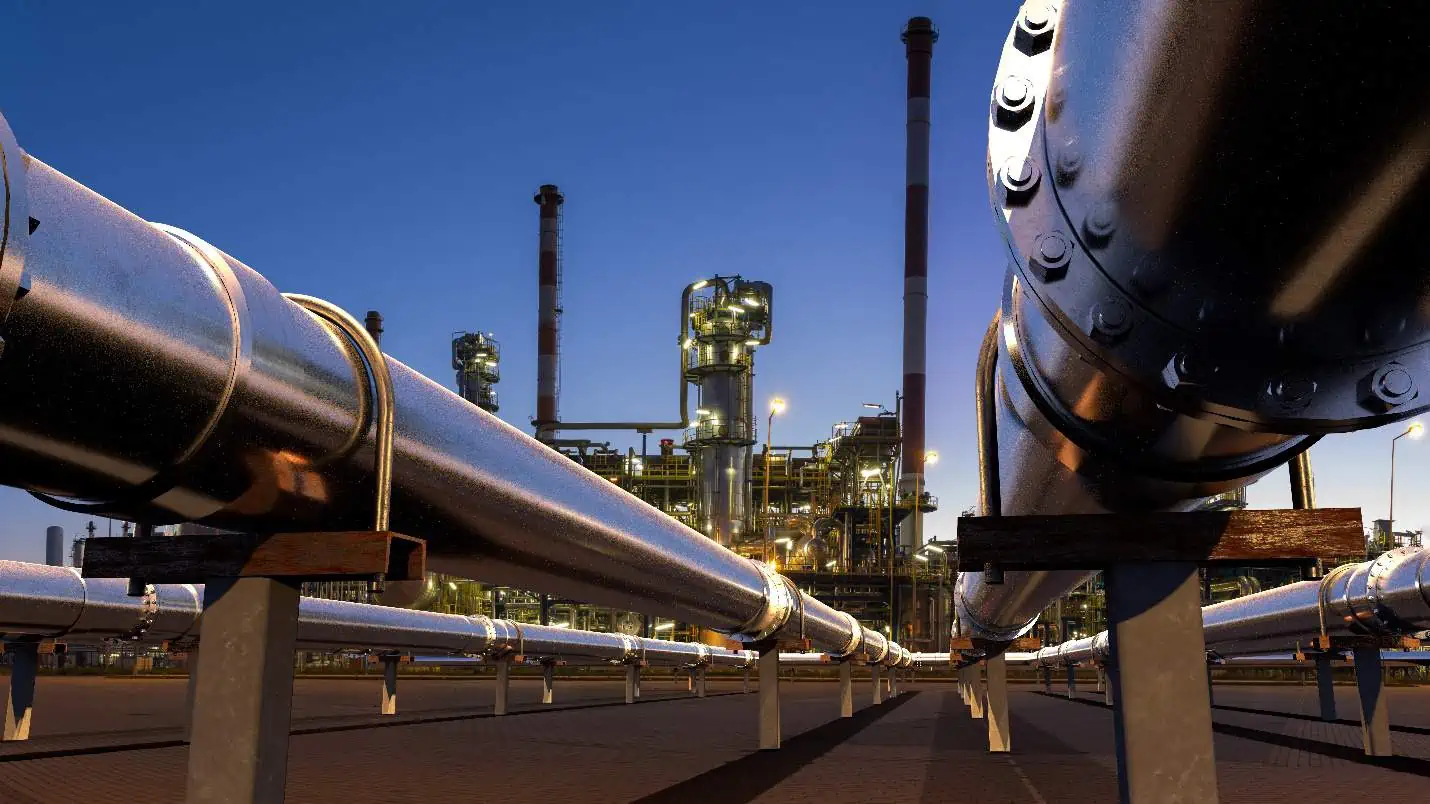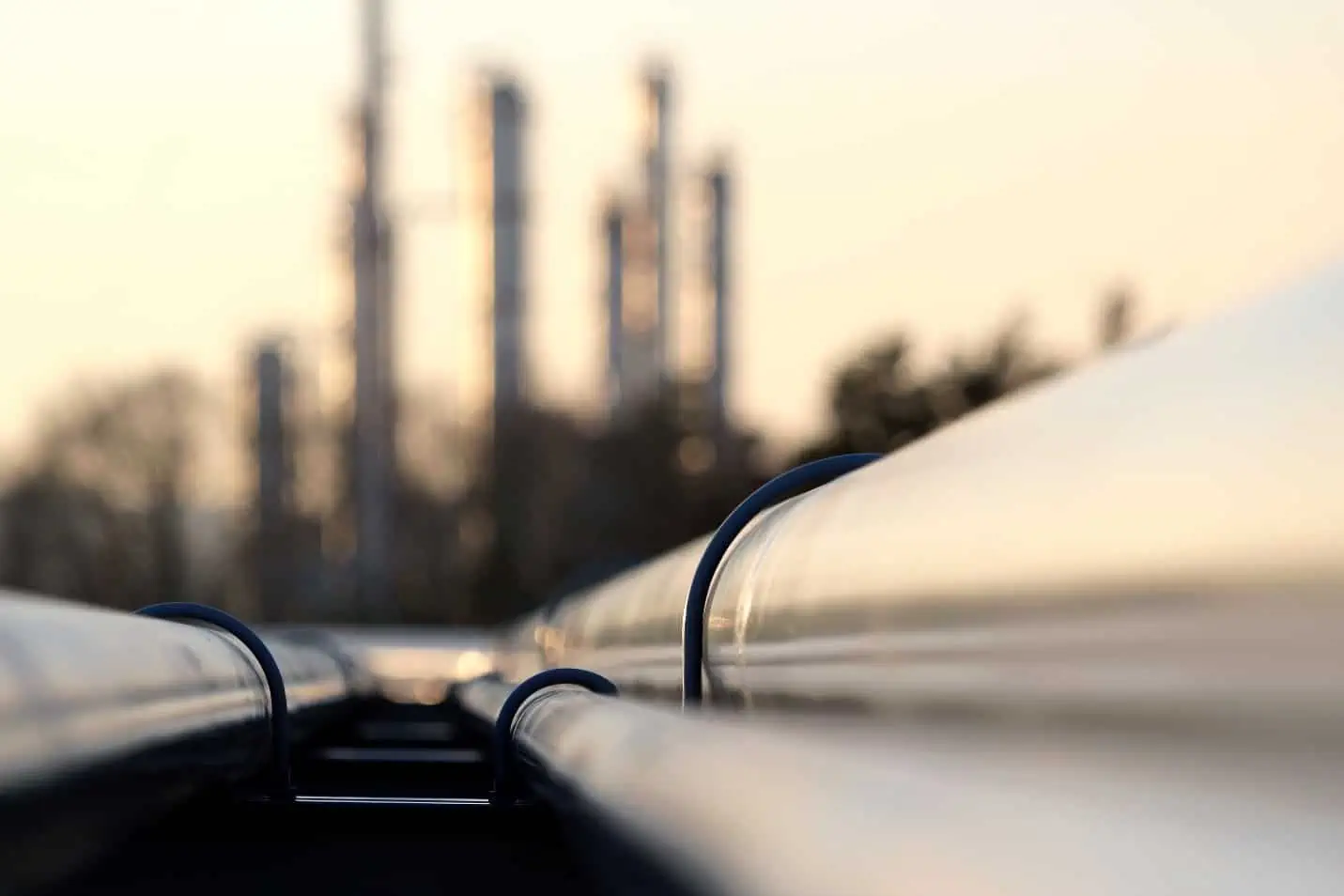In fluid dynamics, venturi meters are commonly used to accurately measure fluids’ flow rate. These devices employ the venturi effect, which governs the behavior of fluids as they flow through pipes with varying cross-sectional areas.

Venturi Meter Principle of Operation
A venturi meter is a flow measurement device widely used in various industries to measure the flow rate of fluids in a pipe.
The venturi meter operates on the principle of Bernoulli’s equation, which relates a fluid’s pressure, kinetic energy, and potential energy at two points in the pipe. When a fluid passes through a venturi meter, it experiences a change in cross-sectional area along its length, leading to a change in velocity and pressure.
At the entrance of the venturi meter, the fluid has a larger cross-sectional area and lower velocity, resulting in higher pressure. As the fluid enters the converging section, the cross-sectional area decreases, and the velocity increases, causing a decrease in pressure. Finally, the cross-sectional area increases again in the diverging section, returning the fluid to its original pressure and velocity.

Elevate Your Engineering With Excel
Advance in Excel with engineering-focused training that equips you with the skills to streamline projects and accelerate your career.

This change in pressure can be measured using a manometer or pressure transducers connected at the inlet and throat sections of the venturi meter. Using Bernoulli’s equation and the known pressure difference, the flow rate of the fluid can be determined. The equation for flow rate (Q) through a venturi meter can be represented as:

Where:
- Q is the flow rate of the fluid
- C is the coefficient of discharge
- A1 and A2 are the cross-sectional areas of the inlet and throat sections, respectively
- P1 and P2 are the pressures at the inlet and throat sections, respectively
- ρ is the fluid density
The discharge coefficient for venturi meters typically varies from approximately 0.94 to 1.0.
| Venturi Throat Diameter Ratio (d/D) | Discharge Coefficient |
| 0.2 | 0.96 |
| 0.3 | 0.98 |
| 0.4 | 0.99 |
| 0.5 | 1.00 |
| 0.6 | 1.00 |
Construction of Venturi Meters
Venturi meters are essential instruments used in fluid flow measurement, designed to assess the flow rate of gases and liquids accurately.
Materials
The materials selected for Venturi meters must be resistant to the media they will be measuring and capable of withstanding the associated temperatures and pressures. Common materials used include:
- Cast iron
- Stainless steel
- Brass
- PVC
Material selection depends on the specific application, considering factors such as corrosion resistance, strength, and cost.
Components
A Venturi meter consists of three main components:
- Converging section
- Throat
- Diverging section
The converging section funnels fluid flow into a narrow passage or throat, causing an increase in speed and a drop in pressure along the flow path. Differential pressure can then be measured between the converging section and throat to calculate the flow rate using the equation above.
Assembly Process
The assembly of a Venturi meter involves the following steps:
- Manufacturing: The individual components are manufactured using techniques such as casting and machining.
- Inspection: Each component is inspected for quality, ensuring dimensional accuracy and compliance with design specifications.
- Assembly: The components are assembled, typically by welding, to form the complete Venturi meter.
- Testing: The final product undergoes pressure tests and calibration to ensure proper function and accurate flow measurement.
Once the Venturi meter has been assembled and tested, it can be installed in the fluid flow system to measure flow rates with high accuracy and reliability.
Types of Venturi Meters
Venturi meters are widely used in various industries to measure fluid flow rates. There are several types of venturi meters, each with its specific applications and advantages. Three common types of venturi meters are the Classical Venturi, Venturi Nozzle, and Herschel Standard Venturi.
Classical Venturi
The Classical Venturi meter, or the Venturi Tube, consists of a converging inlet section, a cylindrical throat, and a diverging outlet section. The inlet section is designed to reduce the fluid’s pressure while increasing its velocity, and the outlet section helps the fluid regain pressure while decelerating its velocity.
Advantages of the Classical Venturi meter include its relatively low head loss, high accuracy, and long-lasting performance. As a result, it is widely used in municipal water and wastewater treatment systems and pipelines for various industries such as oil and gas, chemical, and power generation.
Venturi Nozzle
The Venturi Nozzle is a modified version of the Classical Venturi meter with a shorter converging section and no diverging section. This design simplifies the meter’s construction and makes it more suitable for applications with limited installation space or those requiring a compact, lightweight design.
| Application | Advantages |
| Steam flow measurement | Higher resistance to wear and erosion |
| Gas flow measurement | Lower pressure recovery compared to Classical Venturi |
While the Venturi Nozzle offers some benefits in specific applications, it typically has a higher head loss and lower accuracy than the Classical Venturi meter.
Herschel Standard Venturi
The Herschel Standard Venturi is another variation of the Venturi meter, explicitly designed to comply with American Society of Mechanical Engineers (ASME) and International Organization for Standardization (ISO) standards. It shares a similar structure with the Classical Venturi but features standardized dimensions, allowing for easier comparison and interchangeability between meters from different manufacturers.
Additionally, the Herschel Standard Venturi offers high accuracy, low-head loss, and the ability to handle large flow rates, making it a reliable choice for measuring fluid flow in various industrial applications.
Installation and Calibration
Venturi meters are widely utilized for measuring fluid flow rates in various industries. However, proper installation and calibration ensure accurate and consistent results. This section will discuss the guidelines for installing and calibrating Venturi meters.
Installation Guidelines
Adhering to appropriate installation guidelines is essential for obtaining accurate measurements. The following steps should be considered when installing a Venturi meter:
Ensure the pipe has a straight run of at least 10-15 pipe diameters upstream and five pipe diameters downstream.

Make sure that the Venturi meter is correctly aligned with the flow direction.
Keep the throat section clear to avoid obstructions that might impact the pressure drop and overall accuracy.
Install pressure taps at suitable locations on the Venturi meter’s upstream and downstream sections.
Calibration Process
Once the Venturi meter is installed, a calibration must be carried out to ensure accuracy.
To calibrate the meter, perform the following steps:
First, use a suitable pressure sensor to measure the pressure difference (ΔP) between the upstream and downstream pressure taps.
Obtain the relevant values for fluid density and area parameters A1 and A2 from the operational manual or device documentation.
Using the equation above, use the measured ΔP value and other parameters to calculate the flow rate (Q).
Compare the calculated Q value against a reference flow meter measurement; adjust the discharge coefficient (C), if necessary, to obtain a match.
Finally, repeat the process for several flow rates to ensure a comprehensive calibration.
Regularly calibrating the Venturi meter is essential to maintain accurate and reliable measurements throughout its service life.
Advantages and Disadvantages
Pros of Venturi Meters
Venturi meters offer several advantages when it comes to measuring fluid flow rates. Some of these benefits are:
- Accuracy: Venturi meters are known for their high accuracy in measuring flow rates, particularly compared to other flow meter types. They can be as accurate as 0.5% of the measured value.
- Reliability: Due to their simple design and lack of moving parts, venturi meters are reliable and require minimal maintenance.
- Wide Range of Applications: Venturi meters can be used for various fluids, including gases, steam, and liquids, making them suitable for diverse applications.
- Low Pressure Drop: Venturi meters generate a lower permanent pressure loss than other differential pressure-based flow meters, making them more energy-efficient.
Cons of Venturi Meters
Despite their advantages, venturi meters have drawbacks that should be considered before they are implemented in specific applications. These drawbacks are:
- Initial Cost: The initial cost of a venturi meter can be high, especially for larger sizes, due to the precision manufacturing requirements.
- Installation Requirements: For accurate measurement, Venturi meters require a minimum length of straight pipe sections upstream and downstream. The increased length required may not be feasible in some systems with limited space.
- Limited Sensitivity to Low Flow Rates: Venturi meters may not be ideal for systems with very low flow rates, as their sensitivity decreases in such scenarios.
Applications and Industries
Venturi meters are widely used in various industries and applications due to their accuracy and reliability in measuring fluid flow rates.
Another significant application of venturi meters is in the chemical and petrochemical industries. Accurate measurement of highly corrosive and viscous fluids is critical in these industries for process control, monitoring, and safety purposes. Venturi meters made from corrosion-resistant materials are especially suited for this environment.

Venturi meters also find applications in the oil and gas industry, where they are used to measure flow rates of various fluid phases in the pipelines. This helps in the effective monitoring and management of production and transportation processes.
The food and beverage industry utilizes venturi meters for measuring and controlling the flow of liquids and gases during processing. Their ability to handle a variety of fluid properties and maintain sanitary conditions makes them ideal for this industry.
Furthermore, venturi meters are used in power generation plants, particularly in measuring the flow of steam or cooling water. Accurate flow measurements are critical for optimizing the efficiency of steam turbines and other power plant components.
The broad range of applications and industries that utilize venturi meters speaks to their versatility and reliability in measuring fluid flow rates. For each of these industries, venturi meters contribute to increased efficiency, cost savings, and improved process control.
